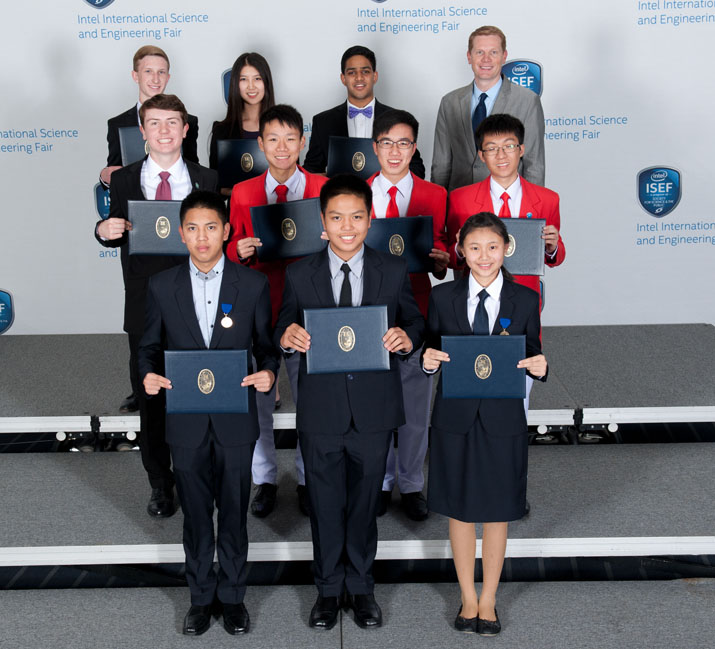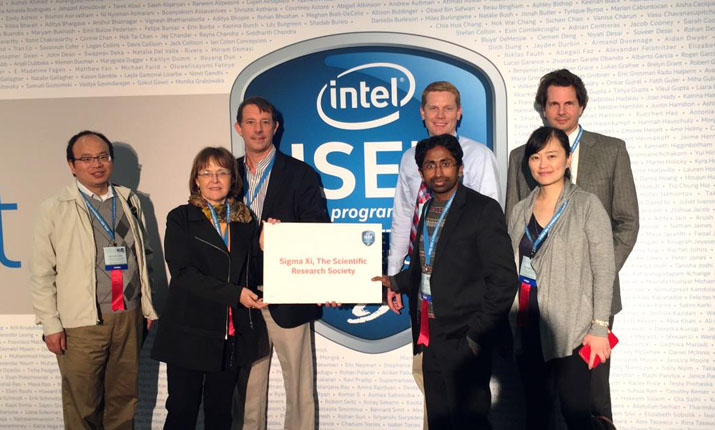Sigma Xi, The Scientific Research Society gave a boost of support on May 14 to four teams of high school students at the Intel International Science and Engineering Fair. Collectively, the teams received $6,000 from Sigma Xi for their outstanding demonstrations of interdisciplinary research.
Twenty-five Sigma Xi members volunteered to select which teams would get the Society’s Team Science Awards. They served as judges for two days in Pittsburgh, Pennsylvania, evaluating team projects to narrow 286 hopefuls down to four winners.
What was it like to judge at the largest pre-college science competition in the world? Ask the Sigma Xi members who were there and they will tell you it was inspiring, a glimpse into the future of science, and a privilege. Here is more of what some of them had to say about their experience.

Photo: Sigma Xi sponsored the Special Award for Team Science at the 2015 Intel International Science and Engineering Fair in Pittsburgh, Pennsylvania. The winners, pictured above with Jamie Vernon, Sigma Xi director of science communications and publications, received a total of $6,000. They ranged in age from 15 to 17 and traveled from Thailand, Virginia, Texas, and Singapore to participate.
Dr. Stephanie Tristam-Nagle: I have been a member of Sigma Xi, Carnegie Mellon Chapter, since 1983, when I joined as a postdoc at CMU. My father, a Ph.D. organic chemist at Merck for most of his career, was also a member of Sigma Xi. As I rose up through the ranks to my current position of research professor, I began to participate in local science fairs. One was the Pittsburgh Regional Science and Engineering Fair (PRSEF, now SciTech) and then I founded a Sigma Xi award at the Pennsylvania Junior Academy of Sciences (PJAS) science fair in 2002.
In 2012, I volunteered to judge at the Intel ISEF (Intel International Science and Engineering Fair), where I was overwhelmed with the quality of the projects. Both of my daughters had participated in the local science fairs, and one of them was selected for the Intel ISEF as a 10th grader, held that year in Detroit.
This year, the quality of the projects at the Intel ISEF was stellar, and I was proud to judge again for Sigma Xi. As our group of judges left the hallway at 5 p.m. on Wednesday, May 13, the parents waiting for their kids were applauding—not only for their children but for us, the judges, and they thanked us. That really warmed my heart.
Dr. Tristam-Nagle is a member of the Carnegie Mellon University Sigma Xi Chapter in Pittsburgh, Pennsylvania. She is a research professor of physics at CMU.
Dr. Gloria Silva: This has been a unique and unexpected experience for me. It was not only the quality of the work presented but also the culture and ingenuity these kids brought to the event. I always preferred to work with advanced college students and graduate students but this event showed me that there is a lot of inspiration and serious devotion to science in high school students. It was inspiring!
Their presentation skills were outstanding, their work showed creativity, innovation, knowledge, serious research, good note-taking and documentation of their observations and progress; a quality of work that justifies their inclusion in this event.
I took my husband to the Special Awards ceremony; he was so impressed that he was looking for more information to help students from our home country to achieve the needed quality to participate in the Intel ISEF some time in a near future.
I hope I can help again next year!
Dr. Silva is a member of the Carnegie Mellon University Sigma Xi Chapter. She is an assistant teaching professor in the Department of Chemistry at CMU.

Photo: These are some of the Sigma Xi members who volunteered to select the winners of the Society’s Team Science Award.
Dr. Linda Winkler: The 2015 Intel International Science and Engineering Fair was a place of overwhelming excitement and talent, brimming with diversity, awash in talent and creativity, and a tremendous privilege to be a part of. The awards that Sigma Xi gives to team projects represent the tremendous potential of interdisciplinary work in the sciences.
As a scientist, I have spent much of my adult career supervising student research at universities and being energized by it. Therefore, I expected to greatly enjoy serving as one of the volunteer life judges at the Intel fair.
However, it quickly became apparent that this was an opportunity to see beyond the present, a spotlight into the future. As I wandered the fair exhibit halls, I was absolutely struck by the incredible wealth of potential. It was a window into the future of science and the scientists who are emerging as leaders and entrepreneurs. As I read poster after poster created by high school students from across the globe, I was struck by the similarities in “doing” good science: observation, hypothesis generation, hours of dedicated careful research, results, and interpretation. However, many of these high school students did far more in using their science to explore solutions to global problems, to seek sustainable solutions for the environment, energy and for human needs, and to create novelty.
I was in awe of all of the possibilities and new directions that were represented in the work of these 1,700 students. I would gladly volunteer again for this or other similar events and recommend that other Sigma Xi members consider it.
Dr. Winkler is a Sigma Xi member and a professor in international affairs at Wilkes University in Wilkes-Barre, Pennsylvania.
Mr. Craig Everhart: It's breathtaking to appreciate the incredible sweep of the students' work, but what surprised me was how congenial it is to work with colleagues that I met only through Sigma Xi and the judging process.
Mr. Everhart is a member of the Carnegie Mellon University Sigma Xi Chapter. He is a principal engineer at NetApp and lives in Pittsburgh.
Dr. Jamie Vernon: Sigma Xi sponsors this event as part of our mission to enhance the health of the research enterprise for the purpose of improving the human condition. By supporting these young scientists, we are contributing to vibrant research in the future.
Dr. Vernon is Sigma Xi, The Scientific Research Society’s director of science communications and publications, based in Research Triangle Park, North Carolina. He is also editor-in-chief of its magazine, American Scientist, and the Society’s interim co-director of operations.